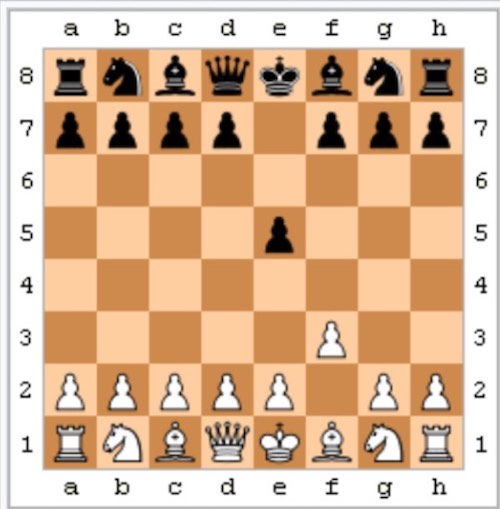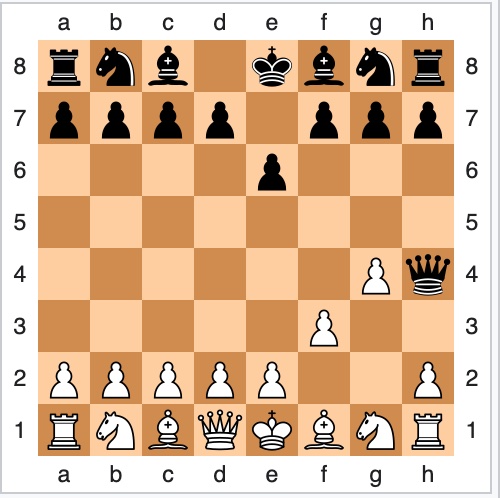The game of Chess, at times, referred to as a “Royal Game”, is an old and interesting tale of battles and victories. In this game, opponents fight, not on the battlefield but on the Chessboard. Chess is an entertaining board game that can be played anytime, anywhere. It improves your focus, patience, and strategic thinking.
Fool’s mate or the shortest checkmate possible in Chess

Look at the above Chessboard. If I tell you that white lost after the next move, will you believe? Yes, that will be the shortest checkmate in Chess with only two moves by both sides. Imagine the white’s move is g4. Then black moves Queen to h4 to checkmate.

This is the shorted possible checkmate in Chess and only occurs in very amateur games when the player (especially the white side) is an absolute beginner.
In games with more experienced players, Chess games go through many moves. While winning is the cherry on the cake, the different phases of the Chess game are its most enticing feature.
Any novice needs to know these stages to prepare better and implement the strategies and increase the chances of winning.
The Opening Phase
A game of Chess is a battle you fight, armed with all your soldiers, cavalry, and royals. So, the opening phase means the commencement of the battle. This includes the first few moves that both opponents make on the Chessboard. Basically, the opening involves moving your pawns, bishops, and knights forward and bringing them to a place on the board where they are in a better position to attack the opponent’s pieces.
It is said that the center of the Chessboard is a crucial area, and if you are able to get your pieces into the central squares, you can control a large area of the board. This gives you an advantage over your opponent.
‘Castling’ is a special King move in the opening phase of the game in order to protect your King and move the rook. This is said to be a special move because it is the only time in Chess when you can move two pieces at a time. The King can move two squares to the right or left when Castling, while the rook moves to the King’s other side. But Castling can only be done if neither of the pieces has moved on the chessboard so far and if there are no other pieces in their way.
The first fifteen to twenty moves of a Chess game are part of the Opening phase. There are many set patterns and pre-decided openings in the game of Chess with interesting names, such as ‘The Sicilian Defense’, ‘The Queen’s Gambit’, ‘French Defense’ and ‘Bishop’s Opening’. There are multiple recorded variations of every opening as well.
Many experienced players play the opening from memorization and quickly move on to the Middlegame, where all the action happens. The Opening phase generally ends when all pieces have moved, and the Kings have castled to safety, but this is not a strict definition.
The Middlegame
The Middlegame is where opponents put all their tactics and strategies into play. Here, it is all about attacking the opponent’s fortification, to be able to reach the King, and to move your pieces into enemy lines.
In the Middlegame, all the pieces have moved out from their original squares on the board, and there are many pieces left to manoeuvre. During the Middlegame, your King is usually in the most dangerous position and must be defended.
Players must carefully attack the opponent’s King while keeping their own pieces safe from a counter-attack. They must be able to take advantage of the opponent’s weakness. This is what makes the game very interesting. Players have to think many moves ahead and anticipate what comes next.
The Middlegame requires careful observation and concentration. Effective pawn position is critical in this phase of the game. Many games are won or lost in the Middlegame itself.
The Endgame
If both players have cleverly completed the second phase, the game continues into the last stage, which is the Endgame. Transitions between the Opening and the Middlegame and between Middlegame and Endgame are not very strict or transparent. Some players consider the game to be in the last phase when opponents have only a couple of pieces other than pawns left on the board, while some consider the Endgame to be when there are no Queens on the board.
The promotion of pawns is vital in the Endgame. Players try and get their pawns to the other side so they can be exchanged for a Queen or other powerful pieces. Endgames require great focus. Players need to put all their experience to use here. The King is an active part of the Endgame. To avoid checkmate, players must ensure that the King does not get cornered by opponents’ pieces to a corner of the chessboard.
Understanding the three phases of a Chess game is essential for beginners as well as those having played the game for a while. As a famous chess player and world chess champion Alexander Alekhine once said, “To win against me, you must beat me three times: in the Opening, the Middlegame and the Endgame”. A sound strategy along with careful, measured tactics will help you win the game.
You can signup here on Classvio to learn Chess from beginner to advanced level. Follow us on FB page here to get notified of our next article on Chess.

